Remember that oval track behind your old high school? It’s not just for track-and-field types anymore. In fact, if you happen to have a track in your neighborhood today, it may soon become the site of your next great workout.
Just under a quarter-mile long, a standard track is full of numbers and landmarks that are great for dynamic, multi-activity workouts. Track workouts like these seem to shrink distance, spicing up your milelong (or longer) runs, and making it easier and more fun for you to improve your aerobic endurance, power and speed.
The concept is simple: By varying your running speed for short distances and adding special tasks and drills, you simultaneously banish boredom and increase your body’s aerobic capacity and strength. As a result, you’ll begin burning oxygen more efficiently, and, over time, you’ll be able to run farther and faster with ease.
Joe Friel, MS, founder and head coach at TrainingBible Coaching and author of Your First Triathlon, says he often has his clients do a dynamic track workout he calls “strides,” which mixes tasks such as plyometrics and skipping drills with running.
“I consider this one of the most important workouts my athletes — pros and novices — do to improve their economy and form,” Friel says. And, he adds, every physical activity — running, cycling, swimming, basketball — will become easier when you make this a part of your exercise routine.
“Each lap specifies a fresh set of tasks to complete, which gives you multiple goals you can achieve during a single run,” explains Troy Jacobson, national director of endurance sports training at Life Time in Chanhassen, Minn. “And collectively, those laps add up to one big goal: running a full mile.”
Plus, unlike simply going out for a jog on a sidewalk, using a standard running track to guide your workout gives you clear measurements to gauge your progress, augmenting your feeling of incremental accomplishment and motivation.
Still worried that a mile is too far to travel? Listen to music or recruit a workout buddy, suggests Amby Burfoot, former Boston Marathon winner, editor at large for Runner’s World magazine and author of The Runner’s Guide to the Meaning of Life. “You can time each other during the fast intervals and help record each other’s progress over time.”
The Workout
This fun, milelong track workout should take between 20 and 30 minutes for beginners (between 10 and 15 minutes for more highly trained athletes) to complete. For each of the four laps (it will be eight laps if you’re on a 200-meter indoor track), do your best to complete the suggested tasks based on your current fitness level. If you find any part of the workout too challenging, you can back off on reps or intensity, or skip an exercise in favor of jogging the equivalent distance on the track. Just build up to doing more of the exercises over time.
Note: Before getting started, begin with a five-minute dynamic warm-up that includes exercises such as light jogging, arm and leg swings, high-knee pulls, and body-weight squats. (See “The Art of the Warm-Up”.)
Lap 1: Run + Walk
Do what’s called a “fartlek,” or speed-play, lap. Jog or walk the turns and go fast on the straights. If you’re with a friend, walk the turns and race each other on the straights. If you’re on a small indoor track, complete the fartlek by time, not distance (jog or walk for 30 seconds, then sprint for 30 seconds; repeat for three minutes).
Goal Achieved: Speed intervals improve cardio endurance and overall running speed. Varying your speed makes the lap feel shorter, too.
Note: “Beware using the inside lane for any prolonged sprinting,” Burfoot warns, since tight, one-directional turns can strain your knees and ankles. If the track isn’t too busy, switch directions or use the outside lanes to keep things balanced. (For more tips on using the track, see “Anatomy of a Track,” below.)
Lap 2: Run + Calisthenics
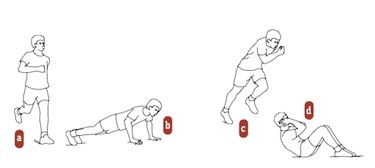
Jog 100 meters (a) (generally a quarter of the track), then do 10 pushups (b): Get into pushup position, hands just wider than shoulder width. Keeping your back straight, bend your elbows to lower yourself to the ground. When your chest is just off the ground, push yourself back up to the starting position.
Sprint 100 meters (c), then do 10 crunches (d): Lie on your back on the grassy infield and bend your knees. Place your hands behind your head and contract your abs, raising your shoulders a few inches off the ground. Keep your neck neutral and your chin pointed toward the sky. Slowly lower yourself back down and repeat.
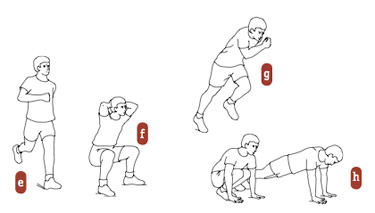
Jog 100 meters (e), then do 10 prisoner squats (f): Stand with feet slightly wider than shoulder width, toes pointed slightly outward, and lace your fingers behind your head. Keeping your elbows pointing straight outward, bend at hips and knees until your thighs are parallel to the ground. Press back up to the starting position and repeat.
Sprint 100 meters (g), then do 10 squat thrusts (h): Stand with feet together. Squat down and place your hands on the ground just outside your feet. In one fluid movement, thrust your feet backward, landing in a pushup position, jump back to the squat position, stand and then repeat.
Goal Achieved: Varying the speed of your 100-meter segments continues that fartlek-interval effect, while the various tasks in between build core strength, working your major muscle groups and giving you more power. Plus, the variety of exercises keeps your mind occupied so you don’t realize you just completed another quarter mile.
Lap 3: Run + Plyometrics
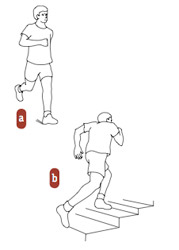
Run 100 meters (a), then jog up and down a flight of stairs or bleachers (b). If no stairs are available, then “high step” or run in place, raising your knees as high as you can, for 30 seconds. This exaggerated movement will put more spring in your step and help your normal running stride feel easier.
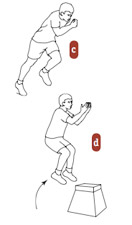
Sprint 50 meters (c), then do 10 plyometric box jumps (d): Find a sturdy platform (such as a stair, step or box) approximately 12 to 24 inches high. Stand in front of the step with feet shoulder-width apart. Jump straight up and land lightly but squarely on the step. Step down and repeat. If no step is available, jump in place.
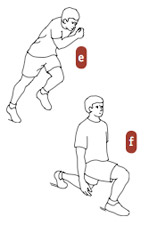
Sprint 50 meters (e), then do walking lunges for 50 meters (f): Step forward with your right leg, lower your hips toward the ground and bend both knees to 90 degrees. Your back knee should almost touch the ground; keep front knee aligned over ankle. Push off the heel of your right foot, lift your left foot and bring it to center, then step forward with your left leg. Alternate legs, continuing for 50 meters.
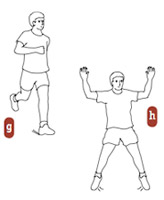
Jog 50 meters (g), then do 10 jumping jacks (h).
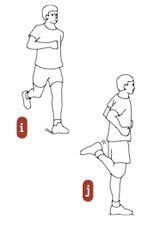
100 meters running with butt kicks (i–j): As you run, bring your heels to your butt without arching your back; repeat as you move down the track for 100 meters. You should feel a strong stretch in your quads.
Goal Achieved: This lap is all about building speed, power and conditioning while keeping you distracted with the tasks, says Jacobson. Speed is a simple equation of stride length times stride frequency, Burfoot explains, and moves such as butt kicks and walking lunges will improve both stride and frequency. They also help improve your running form, which will make you more efficient, so you’ll need less energy to travel the same distance. Try to move seamlessly from task to task without resting in between. As you build endurance and strength, you can increase the number of reps or the distance.
Lap 4: Wind Down
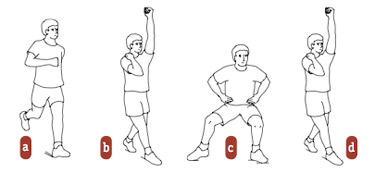
Run 100 meters along the straightaway (a), pushing your pace from a jog to a stride, but keeping it short of an all-out sprint.
Pump arms overhead, as if punching the sky (b), as you walk or jog 100 meters around the next curve.
Side shuffle the length of the straightaway (c), taking care to keep your feet from touching each other. Switch your lead leg halfway down to balance the muscles.
Pump arms overhead (d) as you walk or jog around the final curve.
If you have time, walk one additional lap while sipping water. This will help you cool down further, rehydrate, and begin to flush the waste products out of your muscles.
Goal Achieved: This gradual cool-down also works your upper body, quads and hamstrings.
Anatomy of a Track
To make the most of your workout, it helps to understand how most running tracks are laid out and what the various markings mean. Here are a few helpful facts:
- Most outdoor tracks are 400 meters long. So, if you run four laps, you’re covering 1,600 meters, or just under a mile. Older tracks (those typically built before the ’80s) are 440 yards long, so four laps is exactly a mile.
- Each straightaway on an outdoor track is 100 meters long; the distance is marked with white lines, and sometimes numbers.
- A track’s total distance is measured by the innermost lane. As you move outward on a track, each lane is longer by about 10 meters. All the other lanes are calibrated with staggered starting lines to account for the fact they are longer than the inner lanes.
- On outdoor tracks, it’s standard to run counterclockwise, so that you are always turning left.
- Track etiquette mandates that slower runners use the outside lanes and reserve the inside lane for faster runners.
- The track may include additional markings such as triangles and circles. These are reference markers for hurdle and relay race events. You can ignore them for your workout.
- Indoor tracks vary widely. Some are 300 meters (“oversized”) and others may only be 200 meters or shorter. Some are banked to assist in maintaining speed. Ask the staff at your gym to explain the distance and rules for their track.
This article originally appeared as “The Shortest Mile” in the July/August 2010 issue of Experience Life.
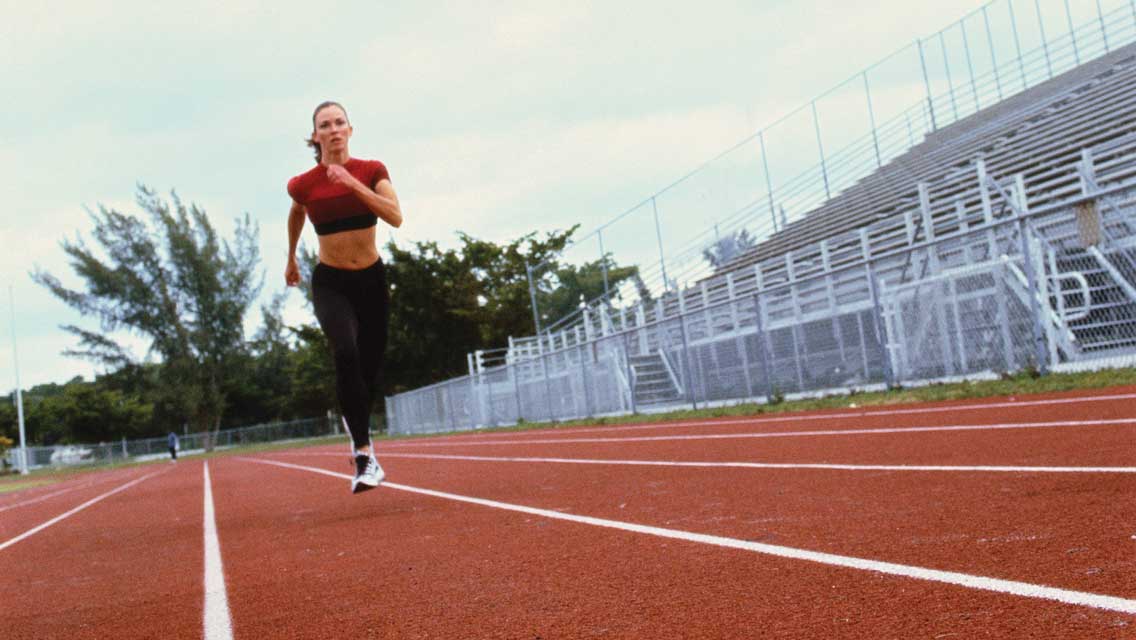
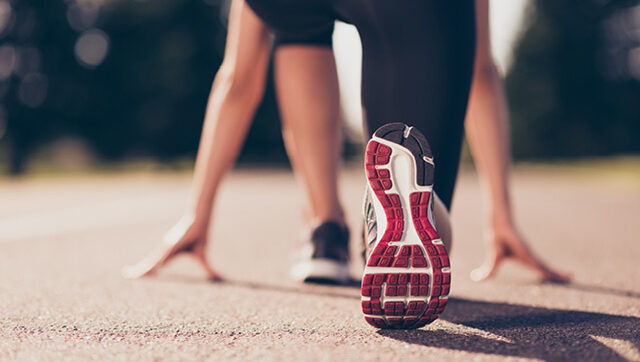
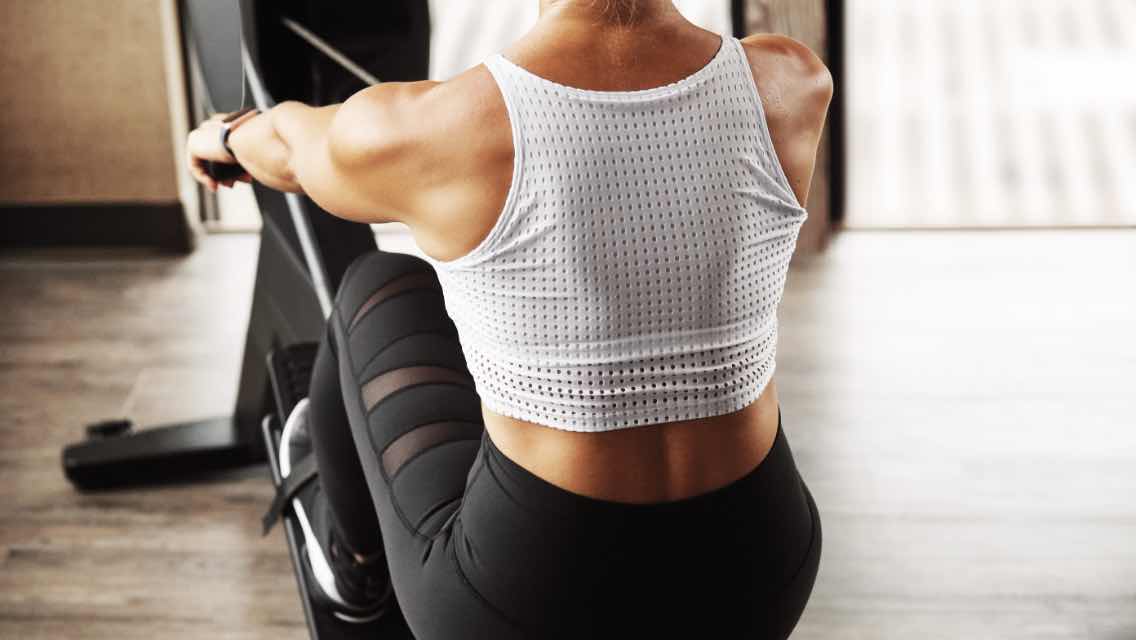

This Post Has 0 Comments